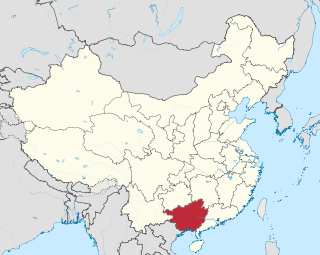E language
| E | |
|---|---|
| Wuse | |
| Kjang E | |
| Region | Guangxi, China |
Native speakers | (30,000 cited 1992)[1] |
| Language codes | |
| ISO 639-3 | eee |
| Glottolog | eeee1240 |
 Guangxi, of which E is spoken in a small area | |
E (simplified Chinese: 诶话; traditional Chinese: 誒話; pinyin: Ē Huà) or Wuse/Wusehua (simplified Chinese: 五色话; traditional Chinese: 五色話; pinyin: Wŭsè Huà; lit. 'Colored Language') is a Tai–Chinese mixed language spoken primarily in Rongshui Miao Autonomous County, Guangxi, China. It contains features of both Tai and Chinese varieties, generally adopting Chinese vocabulary into Tai grammar. E is a tonal language—distinguishing between seven tones—and contains a few rare phonemes: voiceless versions of the more common nasal consonants and alveolar lateral approximant.
Etymology
The E language's unusual pinyin-transliterated name, which is also an autonym, consists of a single letter e.[2] The character, which is written "诶" in Simplified Chinese and "誒" in Traditional Chinese, usually denotes an expression of affirmation.[3] The language's speakers also refer to their language as Kjang E.[2] Wusehua is a derogatory name for E.[4]
Geographical distribution

In 1992, E was spoken by about 30,000 people,[2] but by 2008 this number had dwindled to 9,000.[5] Most E speakers are classified as Zhuang by the Chinese government. E speakers live primarily in the Guangxi autonomous region of China, specifically in the Rongshui Miao county and border areas of Luocheng Mulao. Villages inhabited by E speakers include Xiatan, Simo, Xinglong, and the Yonglei district. Ethnologue classifies E as rank 6b (Threatened). E speakers' most commonly spoken other languages are Yue Chinese and the Guiliu variant of Southwestern Mandarin.[6]
Phonology
E's consonant and vowel inventories are mostly similar to those of its parent languages. However, it contains a few unusual consonants: the voiceless nasal consonants [n̥], [ŋ̥], [m̥], and the voiceless alveolar lateral approximant [l̥]. All are voiceless versions of consonants that, in most languages, are always voiced. E allows syllabic consonants and diphthongs.[5]
|
| ||||||||||||||||||||||||||||||||||||||||||||||||||||||||||||||||||||||||||||||||||||
Like most Southeast Asian languages, including Tai and the varieties of Chinese, E is tonal.[7] The language is described as having seven tones, with the seventh varying allophonically with the length of the vowel it is attached to. With numbers ranging from 1 to 5, with 1 being the lowest tone and 5 the highest, the contours of the various tones in E are as follows.[5]
| Number | Contour | Tone letter | |
|---|---|---|---|
| 1. | 42 | ˦˨ | |
| 2. | 231 | ˨˧˩ | |
| 3. | 44 | ˦ | |
| 4. | 35 | ˧˥ | |
| 5. | 24 | ˨˦ | |
| 6. | 55 | ˥ | |
| 7. | Short | 24 | ˨˦ |
| Long | 22 | ˨ | |
Grammar and lexicon
E is usually classified as a mixed language deriving ultimately from the Tai-Kadai and Sino-Tibetan families, which both inhabit southern China and Southeast Asia.[4] Some non-Chinese scholars, however, consider it a Tai-Kadai language with Chinese influence.[8] Whatever its classification, the grammar resembles that of the Tai branch of Tai-Kadai. Specifically, scholars consider E's grammatical features a blend of Northern Zhuang, Mulam, and Kam.[6][7] The Caolan language of Vietnam displays many similarities with E.[7]
The vocabulary, however, is mostly Chinese, based on Guiliu and the Tuguai variant of Pinghua.[6][7] Out of the 2,000 most commonly used E words, only about 200 are of Tai-Kadai origin.[9] E also inherits elements of these Chinese dialects' phonology and compound word formation.[6] E morphology is primarily analytic, with concepts such as negation expressed with auxiliary words (pat6, m2) and no pronominal agreement.[5]
In its pronouns, E distinguishes for person between first, second, and third; in number between singular and plural; and, in the case of the first-person plural, between inclusive and exclusive we. E does not, however, make distinctions for grammatical gender.[5]
|
|
|
Notes
- ^ E at Ethnologue (18th ed., 2015) (subscription required)
- ^ a b c Edmondson 1992, p. 138.
- ^ Unihan Database 1991.
- ^ a b Encyclopedia of Linguistics 2003, p. 207.
- ^ a b c d e Greenhill, Blust & Gray 2008.
- ^ a b c d Lewis, Simons & Fennig 2014.
- ^ a b c d Edmondson 1992, pp. 135–144.
- ^ Moseley 2012, p. 72.
- ^ Meizhin 2007, pp. 2596–2620.
References
- Edmondson, Jerold A. (1992). The language game: papers in memory of Donald C. Laycock. Canberra: Australian National University.
{{cite book}}: Invalid|ref=harv(help) - Greenhill, S.J.; Blust, R.; Gray, R.D. (2008). "The Austronesian Basic Vocabulary Database: From Bioinformatics to Lexomics – Language: Wusehua (Rongshui)". University of Auckland. Retrieved December 3, 2014.
{{cite web}}: Invalid|ref=harv(help) - Lewis, M. Paul; Simons, Gary F.; Fennig, Charles D. (2014). "Ethnologue: Languages of the World, Seventeenth edition – E". SIL International. Retrieved December 3, 2014.
{{cite web}}: Invalid|ref=harv(help) - Meizhin, Luo (2007). 中国的语言 (in Chinese). Commercial Press.
{{cite book}}: Invalid|ref=harv(help) - Moseley, Christopher (2012). Atlas of the World's Languages in Danger. UNESCO Publishing. ISBN 978-0-956-60524-5.
{{cite book}}: Invalid|ref=harv(help) - International Encyclopedia of Linguistics: AAVE–Esperanto. Vol. 1. Oxford University Press. ISBN 978-0-195-16783-2.
- "Unihan data for U+8A92". Unicode.org. Retrieved November 23, 2014.
- Wei Maofan [韦茂繁] (2011). A study of Wusehua [五色话研]. Beijing: Minzu University Press. ISBN 9787105113651
